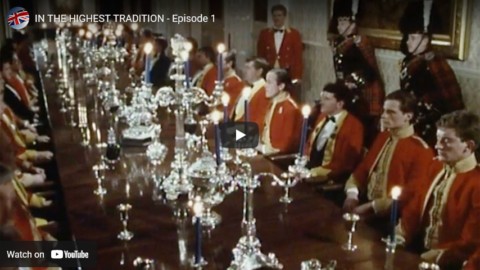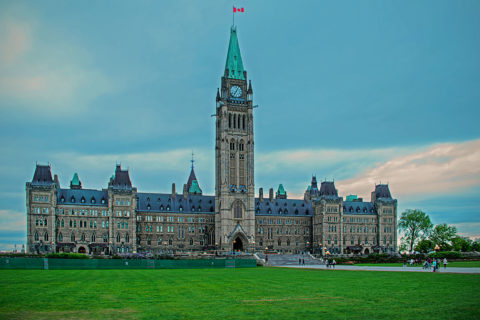British Army Documentaries
Published 18 Oct 2021[From the episode transcript – “Apart from discipline what emerges when you delve into British military tradition is that there’s no such entity as a British army. What you find is a confederation of regiments hopefully fighting on the same side all fiercely preserving their individuality by being as different from one another as possible.”]
First transmitted in 1989, this is the first episode in a six-part series that delves into the world of regimental tradition. This programme includes looks at the origins of Emperor Joseph Bonaparte’s chamber pot, a druid oration, and the story of a goat who escaped being eaten to become a regimental mascot.
© 1989
This production is for viewing purposes only and should not be reproduced without prior consent.
This film is part of a comprehensive collection of contemporary Military Training programmes and supporting documentation including scripts, storyboards and cue sheets.
All material is stored and archived. World War II and post-war material along with all original film material are held by the Imperial War Museum Film and Video Archive.
February 9, 2022
In The Highest Tradition – Episode 1
“The nominal mayor of Ottawa, who apparently serves under the police chief, is another thoroughgoing jackass”
On Tuesday morning, David Warren had some suggestions for reconstructing Ottawa since the truckers seemed to be doing a lot of useful civic work voluntarily:
The Ottawa police chief is an embarrassment, but he seems to validly represent the more tight-assed ratepayers, who have objected to the honking of the big trucks; and the ratepayers are an embarrassment, too. (I’ve tried to warn my readers against the perils of democracy.) The chief cop’s theatrical effort to impound some fraction of the Freedom Convoy’s fuel supply, to demolish their food kitchens, and hand out tickets for things like not having licences on their garbage-collecting carts, is now on display. The nominal mayor of Ottawa, who apparently serves under the police chief, is another thoroughgoing jackass.
I once worked out of Ottawa myself; it is our national capital, I was told. And it is where I acquired my notion of the profound corruption that is brought to that town by the Liberal Party — who dominate its bureaucracies whether they are in or out of power. The arrogance, of the gliberal hot-shots, as well as their extravagant waste and incompetence, has left marks on all the Ottawa institutions, and a good place to begin a clean-up would be by “cancelling” the civil service. (They could be taught to load trucks, instead.)
Too, we should defund the municipal police, or more precisely, replace them. A new police force might possibly be funded just by selling off the spiffy vehicles of the old force (after the cost of repainting them), and their dapper “Zomo” gear might fetch a pretty penny in the costume shops.
The truckers have been polishing the streets, removing even cigarette butts and gum wrappers. They have been guarding the Terry Fox statue on Parliament Hill, and could be asked to mind those of all the other defunct worthies, and slaveholders. (There weren’t any up here, as slavery was outlawed in Upper Canada from the start of the Loyalist settlement, but we can pretend.) Sir John A. Macdonald, our hard-drinking and politically incorrigible founding prime minister, may need special protection.
Among the beneficial effects of the truckers’ protest was to catalyze the ouster of “conservative” “leader” Erin O’Toole:
In the last few months, support for O’Toole from different wings of the party seems to have quietly eroded. A fight over legislation banning conversion therapy was one part of this, particularly the way that senior leadership reportedly sprang a surprise unanimous consent motion in parliament to quickly rush it through, much to the surprise of most of the caucus and especially to an important former supporter of O’Toole and important social conservative within the party, Garnett Genuis, who happened to be (conveniently for party leadership) out of the country on party business at the time. Genius was one of the key supporters of O’Toole who got him elected, but was one of many who appears to have flipped away from O’Toole towards the end.
In the last week of O’Toole’s leadership, a truck convoy opposing Covid measures that has essentially set up camp in parts of downtown Ottawa around Parliament Hill has divided the caucus, with O’Toole constantly shifting positions on it to the satisfaction of absolutely no one. This inability to clearly define and stake out a position was ultimately probably what ended his leadership. As I wrote last week in the National Post, “It has become harder and harder to defend O’Toole because it is increasingly hard to know what you’re defending when you do so. O’Toole seems unable, or unwilling, to clearly articulate positions and even when he does he often ends up backtracking a few days later.”
With O’Toole out, the Conservatives have selected a Manitoba MP and the deputy leader of the party, Candice Bergen, as the interim leader. The race to replace O’Toole is, as of right now, up in the air, with rules and candidates all still to be announced. The presumptive frontrunner is the shadow finance minister, Pierre Poilievre. He is extremely popular amongst the Tory base, unapologetic, and easily the party’s most gifted and talented communicator. He has strong name recognition already, and if he runs will be the clear favourite. Other names being thrown around are previous candidates Peter MacKay and Leslyn Lewis, current MPs Michelle Rempel-Garner and Michael Chong, and the mayor of Brampton Patrick Brown.
A Liberal backbencher has broken ranks with Justin Trudeau to call for an end to the Wuhan Coronavirus restrictions and a return to normal life for Canadians:
The federal government needs to quickly offer a road map for the lifting of COVID-19 restrictions, according to Quebec Liberal MP Joël Lightbound, citing mental health concerns from pediatricians and the parents of depressed children, and the inability of many to earn a living from a “MacBook at their cottage.”
Lightbound, MP for Louis-Hébert, chair of the industry committee and the Quebec Liberal caucus, and a former parliamentary secretary to the finance minister, said the Liberal government has changed in policy and in tone since last year’s election campaign and appears unwilling to adapt to the evolution of the pandemic.
“Now the approach stigmatizes people and divides people,” he told reporters this morning, pointing to the loosening of restrictions in European countries with lower vaccination rates than Canada.
Lightbound said he raised his concerns in caucus to Prime Minister Justin Trudeau, but owes it to constituents to publicly voice his concerns and is ready for potential political consequences for speaking out.
But, he added, other Liberal MPs share his concerns and the party has historically been “open for dissent and different opinions.”
Matt Gurney‘s second day report from the streets of Ottawa isn’t as upbeat as yesterday’s installment:
My second report (of three planned) from Ottawa will be a grimmer read than the first. But we might as well start with a moment or two levity, of a kind.
On Tuesday afternoon, I returned to the site of the main protest, on Wellington Street, right along the southern side of Parliament Hill. The crowd was, in a general sense, the same as described in my first dispatch. The barbecues were going, the coffees were being poured, and the speeches were being made off the back of a flatbed truck, with a large Canadian flag, suspended from the chain of a large mobile crane hanging over it. The crowd had been entertained for some time by some singing, mostly of upbeat recent-ish pop hits. The singer was enthusiastic, positive, cheerful and, alas, not very good. She got plenty of applause anyway, especially each time she did a shout out to “Freedom!”
And then things got weirder.
One of the main responses to my first dispatch was skepticism that a tall white dude who easily blends in with the protest crowd was getting a “representative” view at the protest site. I shared that concern! And I was really explicitly clear about that in the first piece. You can take my reporting with all the lumps of salt you want. I am indeed a white dude, and so is almost everyone else at the protest site. It’s not universally white, but it’s overwhelmingly white. People wanted to know if my experience would have been different if I were a woman, or a person of colour, or wearing a mask, or any combination of those. I am also curious about that. I just don’t know, and can’t know. But I did make a point today of watching how anyone who was wearing a mask, or a person of colour, or a woman fared in the crowd. In my two hours on site today, I observed no problems. I don’t draw any conclusions from that, nor do I deny that it might take some bravery to walk through that crowd as a masked woman of colour. But in terms of what I saw, that’s all I can honestly tell you.
[…]
It’s a different place at night. Not in a good way. I got there around 8 p.m. or so on Monday. The streets had almost emptied out. Most of the office workers had gone home by then, I guess. The cheerful revellers had cleared out, too. The music had stopped, the folding tables mostly cleared and put away, and the encampment was quiet. The roving police patrols I’d noticed keeping such an overt presence during the day were gone as well. Instead, the officers had pulled back, way back, and taken positions on the streets and at intersections around the protest site. I saw one foot patrol go in, but just one, and not very far.
By 9:30 p.m., as I continued my walk through the area, there was a very clear difference between the vibe on either side of the police positions. Outside, the city was quiet — the horns had stopped, and there were no fireworks, and it felt like a pretty normal Canadian city. People milled about walking their dogs or picking up food. The nicotine addicts puffed away outside doorways of condo towers and office buildings.
Inside those cordons, though, things were not so good.
A Tour of Chapuis Armes: Home of the MR-73 Revolver
Forgotten Weapons
Published 5 Oct 2021http://www.patreon.com/ForgottenWeapons
https://www.floatplane.com/channel/Fo…
Cool Forgotten Weapons merch! http://shop.forgottenweapons.com
With the MR-73 revolvers finally becoming regularly available in the US, I figured it would be really interesting to see how they are made! So, I headed over to Chapuis Armes, where the Directeur Général, Vincent Chapuis, gave me a really nice tour. Want to see? Let’s go in …
Contact:
Forgotten Weapons
6281 N. Oracle 36270
Tucson, AZ 85740
QotD: Paper or plastic?
In his Nobel Lecture, The Pretence of Knowledge, Friedrich Hayek told us that it was never going to be possible to centrally plan an economy for economies are big, complex, even chaotic, things. That centre can never gain enough information in real time to be able to make decisions which bear much relation to reality. We can also run his logic backwards, if we do insist upon planning then we can only have a simple economy – all the knowledge we have allows us to plan – and simple economies are poor ones with poor people in them. Planning and poverty or market chaos and wealth: take your pick.
This point is illustrated in microcosm by those trying to get rid of single use plastic bags. The 5p charge for plastic bags has meant the sale of billions of so-called bags for life, which use twice as much plastic as the cheaper alternative. All those bags for life mean we use more plastic than we started with and even, possibly, more bags themselves. This was something that was warned about before the plastic bag charge was introduced, with some observing that even “single use” bags did tend to get used more than once.
So far, then, we have learnt that the planning deployed to reduce plastic has had the opposite effect. That, however, has not stopped the central planners from redoubling their efforts. The necessary charge for a bag is to double, the system is to be expanded to the tens of thousands of small shops that don’t currently have to charge. “It doesn’t work, let’s have more of it”, the cry of bureaucracies through the ages.
But this is the blending of government planning with the fashionable nostrums of our day so of course it gets worse. It’s not even true that the bags for life – and especially not the cotton ones, even less so the organic cotton – are more environmentally friendly than the single use ones. Even recycled ones use more resources than single-use ones – for yes, recycling is an industrial activity using energy and other resources.
We can even construct a little spectrum here. How many times do we need to reuse a bag for it to have as little resource use – and thus environmental effect – as just the one use of those thin single use plastic ones? Obviously enough, the single use that we’re told not to use has a value of one here. The bag for life must be reused 35 times. A bag for life from recycled plastic 84 times. A paper bag must be reused 43 times – yes, paper. A cotton bag 7,100 times and an organic cotton? 20,000.
Which is the environmentally friendly option here? Clearly and obviously the one that everyone insists we must not use. So much for fashionable nostrums then.
Tim Worstall, “Plastic bags and the problem with central planning”, CapX, 2019-01-02.






